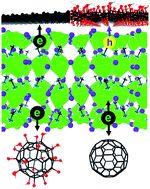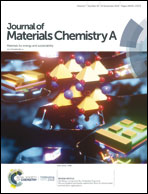Structural and electronic properties of multifunctional carbon composites of organometal halide perovskites†
Abstract
Characterization of the structural and electronic properties of organometal halide perovskite interfaces is fundamental to fully exploit the possibilities of application of this exceptional material. First principles modelling was carried out on the composites of carbon nanostructures and methylammonium lead triiodide (CH3NH3PbI3 and MAPbI3): graphene/MAPbI3, graphene oxide/MAPbI3, C60/MAPbI3 and C60(OH)24/MAPbI3. The interfacial effects of carbon modifiers on the perovskite electronic properties, dipole moment and work function were investigated in detail to finally elucidate the photoexcitation mechanisms at these heterojunctions. We demonstrated distinct charge reorganization at all interfaces governed by the interplay of Pauli repulsion and van der Waals attraction in the case of graphene and C60, and charge transfer and electronic states hybridization in the case of GO and C60(OH)24. Graphene forms a conductive junction and greatly reduces the work function. GO is shown to behave as an excellent hole collecting material that should effectively reduce charge recombination events. Fullerenol, besides reducing the work function, was shown to be a superior electron collector over fullerene. This work contributes to clarifying the function of carbon materials as interfacial layers in optoelectronic devices based on perovskites.



 Please wait while we load your content...
Please wait while we load your content...